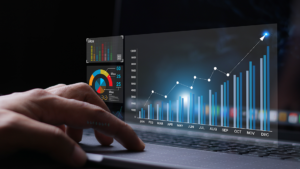


Srinivasan Subramani
6 Minutes read
Industrial Robotics Embraces AI-Powered Automation to Shape the Future
In recent years, industrial robotics has undergone a transformative shift with the integration of artificial intelligence (AI). What once were rigid, pre-programmed machines have evolved into intelligent systems capable of learning, adapting, and optimizing their operations. This convergence of AI and robotics redefines manufacturing and production, driving efficiency, accuracy, and flexibility to new heights. However, as promising as it is, this advancement comes with its challenges. Let’s explore the opportunities and hurdles AI-powered automation brings to industrial robotics, and how the industry addresses these challenges.
The Impact of AI on Robotics
DevOps combines software development and IT operations, promoting teamwork, automation, and ongoing improvement to deliver software quickly and reliably.
Fundamental Principles of DevOps
Historically, conventional robots in manufacturing were confined to performing repetitive tasks with minimal variation. The integration of AI marks a significant shift, enabling robots to engage in dynamic decision-making, process data in real-time, and adapt to changing conditions. This evolution transforms them into intelligent, collaborative, and autonomous systems that can handle a broader range of tasks with increased efficiency and flexibility.
With AI technologies like machine learning, deep learning, and computer vision, robots can perform intricate tasks such as assembly, inspection, and maintenance with greater efficiency and less human oversight.
Critical Benefits of AI-Powered Automation in Industrial Robotics
Enhanced Productivity
AI-powered robots can operate continuously without fatigue, drastically reducing downtime. Their ability to learn and improve performance over time ensures faster production cycles, minimizing errors and optimizing output.
Precision and Quality Control
AI-driven robots can perform tasks with extreme accuracy. In electronics and automotive manufacturing, this level of precision ensures fewer defects and better-quality products.
Flexibility and Adaptability
AI allows robots to handle multiple tasks, adjust to changes in production lines, and even switch between different functions autonomously. This is especially valuable in industries with dynamic production requirements.
Increased Safety
In hazardous industrial environments, AI-powered robots can take on dangerous tasks, reducing the risk of injury to human workers. Collaborative robots (cobots) also improve safety by working alongside humans with intelligent obstacle-detection and avoidance capabilities.
Challenges Facing AI-Powered Robotics in Industry
While the benefits are numerous, integrating AI into industrial robotics has challenges. . These challenges range from technological barriers to societal concerns.
Complexity of Integration
Implementing AI in existing industrial systems is complex. Many factories rely on legacy systems, making it challenging to integrate AI-powered robotics seamlessly. Furthermore, training AI models to function efficiently in varied environments requires significant data, which isn’t always readily available.
High Initial Investment
The cost of deploying AI-powered robots can be prohibitive, especially for small- and medium-sized enterprises (SMEs). The financial investment is often a barrier to widespread adoption, from the hardware required to the specialized skills needed to maintain AI systems.
Ethical and Security Concerns
AI-powered systems rely on large amounts of data, leading to concerns about privacy, data security, and the ethical use of AI. Additionally, the autonomous nature of AI-driven robots raises questions about accountability in the event of malfunctions or accidents.
Lack of Adaptability in Complex Environments
AI-powered robots struggle in unpredictable or highly variable environments despite their advanced capabilities. For example, the robots may not perform as efficiently in industries like construction or agriculture, where conditions are constantly changing.
Overcoming Challenges: A Vision for the Future
The challenges facing AI-powered industrial robotics are significant but manageable. Companies invest in research and development to advance AI capabilities, while governments are creating frameworks that address technological and social concerns.
One emerging trend is using AI to create “digital twins” – virtual replicas of physical systems. These twins allow companies to simulate and optimize robot operations before deploying them in the real world, reducing errors and improving efficiency.
Future Trends in AI-Powered Industrial Robotics
As we look ahead, several key trends are poised to further shape the landscape of AI-powered industrial robotics.
Greater Human-Robot Collaboration
The rise of collaborative robots—commonly known as cobots—marks a trend toward increased human-robot collaboration. These systems work with human operators to boost productivity while ensuring a safe working environment.
Better Predictive Maintenance
AI’s capability to analyse extensive data will lead to more advanced predictive maintenance. By continuously monitoring equipment performance and detecting anomalies in real time, AI-powered robots can prevent breakdowns before they occur, reducing downtime and cutting maintenance costs.
Sustainability and Eco-Friendly Practices
As the focus on sustainability grows, AI-powered robots will be crucial in optimizing resource use and minimizing waste. These systems can contribute to more sustainable manufacturing by improving energy efficiency and streamlining supply chains.
Advanced AI Algorithms for Learning and Adaptation
Next-generation AI algorithms will enable robots to learn more effectively from their surroundings. Techniques like reinforcement learning will allow robots to adapt to new tasks and environments with less human intervention.
More AI-Driven Analytics
With the surge in data production, the role of AI-powered analytics in industrial robotics will be crucial. This advancement will allow companies to understand their operational efficiency better, pinpoint enhancement opportunities, and base their decisions on solid data analysis.
Conclusion
AI-powered automation revolutionizes industrial robotics, creating a future where machines are tools and intelligent collaborators. While challenges such as integration complexity, workforce displacement, and security concerns remain, ongoing innovations and evolving regulations pave the way for a more seamless adoption of AI in industries.
As AI continues to evolve, its role in industrial robotics will only expand, driving more sustainable, efficient, and adaptable manufacturing processes. For businesses ready to embrace this technology, the future has untapped potential and limitless possibilities. The next generation of industrial robots, empowered by AI, will be at the heart of a smarter, safer, and more efficient industrial landscape.





